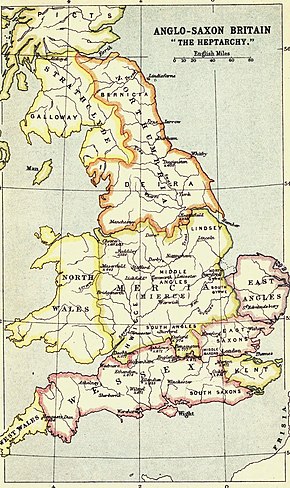
Back الممالك السبعة لإنجلترا Arabic Heptarquía anglosaxona AST Гептархія Byelorussian Гептархія BE-X-OLD Heptarquia anglosaxona Catalan Sedm anglosaských království Czech Heptarkiet Danish Heptarchie German Επταρχία Greek Heptarkio Esperanto

The Heptarchy is the name for the division of Anglo-Saxon England between the sixth and eighth centuries into petty kingdoms, conventionally the seven kingdoms of East Anglia, Essex, Kent, Mercia, Northumbria, Sussex, and Wessex. The term originated with the twelfth-century historian Henry of Huntingdon and has been widely used ever since, but it has been questioned by historians as the number of kingdoms fluctuated, and there was never a time when the territory of the Anglo-Saxons was divided into seven kingdoms each ruled by one king. The period of petty kingdoms came to an end in the eighth century, when England was divided into the four dominant kingdoms of East Anglia, Mercia, Northumbria, and Wessex.[1][2]
- ^ Kirby, D. H. (2000). The Earliest English Kings (Revised ed.). London, UK: Routledge. pp. 4–7, 19. ISBN 978-0-415-24211-0.
- ^ Keynes, Simon (2014). "Heptarchy". In Lapidge, Michael; Blair, John; Keynes, Simon; Scragg, Donald (eds.). The Wiley Blackwell Encyclopedia of Anglo-Saxon England (2nd ed.). Chichester, West Sussex: Wiley Blackwell. p. 238. ISBN 978-0-470-65632-7.